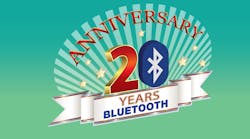Can you believe it? Bluetooth is 20 years old. My, my, how time flies. Who would have thought back in 1998 that this nascent technology would become an important part of our lives? Today BT is everywhere. Go ahead and count up the number of BT radios you use every day. Be amazed.
Taking inventory, I determined today that I must own about a half-dozen BT radios. It appears in our smartphones, our hands-free connections in our vehicles, and in a couple of BT speakers and headphones. And in my hearing aids. I am probably missing something, as BT today is highly embedded along with Wi-Fi into many other devices. As indictors, consider that almost 4 billion Bluetooth devices are expected to ship in 2018.
Back in 1998 there were very few short-range radio standards. It all started when the FCC opened the industrial-scientific-medical (ISM) license-free spectrum 13 years earlier, in 1985. Then Wi-Fi turned up in 1997 with the initial 802.11 standard. FCC CFR 47 Part 15 radios could be built with some available chips from Motorola (then Freescale, now NXP), Micrel, and others. But overall the short-range market had not emerged.
Cambridge Silicon Radio (remember them?) made some of the initial chips. With these, BT set off the big movement to cordless connectivity of printers and other devices. Now we have many other short-range standards like ZigBee, Z-Wave, 802.15.4 and its spin-offs, NFC, proprietary ISM band products, and a half dozen or more that target the Internet of Things (IoT) space.
Bluetooth is a highly complex wireless technology. It uses frequency hopping spread spectrum (FHSS) techniques with GMSK and other modulation schemes in the unlicensed 2.4 GHz band. It is robust enough to withstand all the background noise and EMI from Wi-Fi and other devices and services in this popular band. Designing with it was initially a challenge. But today, it is much easier with multiple chip vendors and the many advances put forth by the Bluetooth Special Interest Group that oversees the standard. For example, getting devices to recognize and communicate with one another, or pairing, was difficult. Now it is virtually automatic.
Over the years, the BT SIG has evolved the early standard into a much more flexible technology. BT 2.0 bumped the maximum raw data rate from its initial 1 Mb/s to 3 Mb/s. BT 3.0 added working capability with Wi-Fi. Version 4.0 introduced Bluetooth Low Energy, defining a version with minimal power consumption and features making it attractive to IoT applications. Version 5 gives lower speed but much longer range, and even a mesh networking option. No doubt continual enhancements are possible.
One of the big reasons why BT has been so widely adopted is its Profiles. These are detailed descriptions of how to implement many common applications. Profiles help to make BT devices compatible and also reduce development time and cost.
Bluetooth has found its way into almost every possible application. Home audio, automotive, and smartphones are the biggest markets. BT is also big in IoT. Building automation, industrial, and smart cities are other adopters. And what about those BT beacons?
There are many BT suppliers. One I got familiar with recently was Nordic Semiconductor. They have an interesting Bluetooth Low Energy chip line (nRF52 series) and lots of good development tools. I recently acquired one of their Thingy52 BT demo and development kits.
BT modules are also popular. Lemos International carries a wide range of modules, wireless interfaces, and accessories like access points. If you are not a wireless expert, you can still embed wireless without a hassle into a product with a module.
Bluetooth is an excellent wireless technology that will be with us for a long time. Given that the Bluetooth SIG now has over 33,000 members, we can probably assume it will continue to evolve into a better standard. Congrats and thanks to the Bluetooth SIG.

